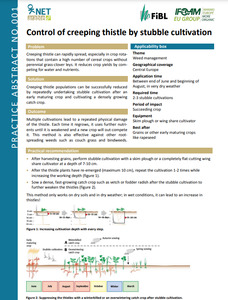{Tool} Control of creeping thistle by stubble cultivation (OK-Net Arable Practice Abstract). [Ganzflächige Bekämpfung der Ackerkratzdistel durch Stoppelbearbeitung.] Creator(s): Dierauer, Hansueli; Siegrist, Franziska and Weidmann, Gilles. Issuing Organisation(s): FiBL - Research Institute of Organic Agriculture. OK-Net Arable Practice Abstract, no. 001. (2017)
Preview |
PDF
- German/Deutsch
(Ganzflächige Bekämpfung der Ackerkratzdistel durch Stoppelbearbeitung)
205kB |
Preview |
PDF
- English
(Control of creeping thistle by stubble cultivation)
205kB |
Preview |
PDF
- Dutch/Nederlands
(Controle van akkerdistel door stoppelbewerking)
383kB |
![[thumbnail of 2023-01-09 12_44_50-Protokoll.png]](/31016/43.hassmallThumbnailVersion/2023-01-09%2012_44_50-Protokoll.png)  Preview |
Image (PNG)
- Cover Image
- English
159kB |
Document available online at: https://orgprints.org/31016/
Summary in the original language of the document
Multiple cultivations lead to a repeated physical damage of the thistle. Each time it regrows, it uses further nutrients until it is weakened and a new crop will out-compete it. This method is also effective against other root-spreading weeds such as couch grass and bindweeds.
• After harvesting grains, perform stubble cultivation with a skim plough or a completely flat-cutting wing share cultivator at a depth of 7-10 cm.
• After the thistle plants have re-emerged (maximum 10 cm), repeat the cultivation 1-2 times while
increasing the working depth.
• Sow a dense, fast-growing catch crop such as vetch or fodder radish after the stubble cultivation to
further weaken the thistles.
This method only works on dry soils and in dry weather; in wet conditions, it can lead to an increase in
thistles!
Summary translation
Die Ackerkratzdistel kann sich vor allem in getreidelastigen Fruchtfolgen ohne mehrjähriges Kleegras stark ausbreiten, die Kulturen um Wasser und Nährstoffe konkurrenzieren und die Ernte erschweren.
Wiederholte Stoppelbearbeitung nach einer früh räumenden Kultur. Anschliessend Anbau einer dichtwachsenden Zwischenfrucht.
Durch die Bodenbearbeitung wird die Distelwurzel durchtrennt. Bei jedem Neuaustrieb hat sie erhöhten Nährstoffbedarf und ist schliesslich so geschwächt, dass sie sich nicht mehr gegen die Kulturpflanzen durchsetzen kann. Die Massnahme eignet sich auch zur Regulierung anderer Wurzelunkräuter wie Quecken und Winden.
• Nach der Getreideernte mit dem Schälpflug oder einem ganzflächig schneidenden Flügelschargrubber eine Stoppelbearbeitung in 7- 10 cm Tiefe durchführen.
• Nach dem Wiederaustrieb der Disteln (max. 10 cm) 1- bis 2-mal die Stoppelbearbeitung mit etwas grösserer Arbeitstiefe wiederholen.
• Um die Disteln weiter zu schwächen, nach der Stoppelbearbeitung eine schnell wachsende, dicht schliessende Zwischenfrucht wie Sommerwicke oder Ölrettich säen.
Die Methode funktioniert nur bei trockenem Boden und anhaltend trockener Witterung; unter feuchten Bedingungen kann sie im Gegenteil die Vermehrung der Disteln fördern!
| EPrint Type: | Practice tool |
|---|---|
| What problem does the tool address?: | Creeping thistle can rapidly spread, especially in crop rotations that contain a high number of cereal crops without perennial grass-clover leys. It reduces crop yields by competing for water and nutrients. |
| What solution does the tool offer?: | Creeping thistle populations can be successfully reduced by repeat-edly undertaking stubble cultivation after an early maturing crop and cultivating a densely growing catch crop. |
| Country: | Switzerland |
| Type of Practice Tool: | Practice abstracts |
| Location: | Central Europe |
| Theme: | Weed management |
| Keywords: | arable crops, arable farming, weed management |
| Keywords: | arable crops, arable farming, weed control, mechanical weed control, catch crops, tillage |
| Agrovoc keywords: | Language Value URI English arable farming http://aims.fao.org/aos/agrovoc/c_36528 English mechanical weed control http://aims.fao.org/aos/agrovoc/c_24200 English tillage http://aims.fao.org/aos/agrovoc/c_7771 English weed control http://aims.fao.org/aos/agrovoc/c_8345 English catch crops http://aims.fao.org/aos/agrovoc/c_29684 |
| Subjects: | Crop husbandry > Soil tillage Crop husbandry > Weed management |
| Research affiliation: | European Union > Horizon 2020 > OK-Net Arable > OK-Net-Arable Tools Switzerland > FiBL - Research Institute of Organic Agriculture Switzerland > Knowledge exchange > Advice European Union > Horizon 2020 > OK-Net Arable International Organizations > International Federation of Organic Agriculture Movements IFOAM > IFOAM Organics Europe European Union > Organic Farm Knowledge |
| Horizon Europe or H2020 Grant Agreement Number: | 652654 |
| Related Links: | https://organic-farmknowledge.org/tool/31016 |
| Project ID: | ofk |
| Deposited By: | Forschungsinstitut für biologischen Landbau, FiBL |
| ID Code: | 31016 |
| Deposited On: | 11 Jan 2017 15:39 |
| Last Modified: | 02 May 2024 10:31 |
| Document Language: | English, German/Deutsch, Dutch/Nederlands |
| Status: | Published |
Repository Staff Only: item control page

 Download Statistics
Download Statistics Download Statistics
Download Statistics
